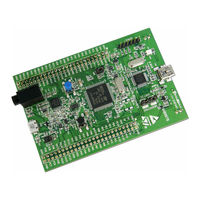ST STM32F446 Series Development Board Manuals
Manuals and User Guides for ST STM32F446 Series Development Board. We have 2 ST STM32F446 Series Development Board manuals available for free PDF download: Reference Manual, Application Note
ST STM32F446 Series Reference Manual (1328 pages)
advanced Arm-based 32-bit MCUs
Brand: ST
|
Category: Microcontrollers
|
Size: 16 MB
Table of Contents
-
-
Glossary52
-
I-Bus54
-
D-Bus54
-
S-Bus54
-
Busmatrix55
-
Introduction56
-
Bit Banding60
-
Introduction64
-
Erase70
-
Programming71
-
Interrupts72
-
Option Bytes72
-
Low-Power Modes100
-
Sleep Mode102
-
Low Power Mode102
-
Stop Mode103
-
Standby Mode106
-
PWR Register Map115
-
Power Reset116
-
Reset116
-
System Reset116
-
Clocks117
-
HSE Clock120
-
HSI Clock121
-
LSE Clock122
-
LSI Clock122
-
RTC/AWU Clock123
-
Watchdog Clock124
-
RCC Registers127
-
RCC Register Map172
-
Port Pins185
-
GPIO Registers187
-
SYSCFG Registers195
-
(Syscfg_Exticr1)197
-
(Syscfg_Exticr2)198
-
(Syscfg_Exticr4)199
-
(Syscfg_Exticr3)199
-
DMA Introduction203
-
DMA Overview205
-
DMA Transactions206
-
Arbiter208
-
DMA Streams208
-
Circular Mode212
-
Fifo215
-
Flow Controller219
-
Error Management222
-
DMA Interrupts223
-
DMA Registers224
-
DMA Register Map234
-
NVIC Features238
-
EXTI Registers246
-
AHB Interface252
-
SDRAM Controller306
-
Low-Power Modes313
-
FMC Register Map323
-
Introduction325
-
QUADSPI Pins326
-
QUADSPI Usage335
-
Ncs Behavior338
-
ADC Introduction354
-
ADC Clock360
-
Timing Diagram361
-
Analog Watchdog362
-
Scan Mode363
-
Data Alignment365
-
Data Management369
-
Using the DMA369
-
Multi ADC Mode370
-
Interleaved Mode375
-
ADC Interrupts382
-
ADC Registers383
-
(Adc_Cdr)398
-
DAC Introduction401
-
DAC Data Format403
-
DAC Conversion404
-
DMA Request406
-
Noise Generation406
-
-
TSEL2[2:0] Bits410
-
DAC Registers413
-
(Dac_Dhr12L1)417
-
(Dac_Dhr12L2)418
-
(Dac_Dhr12Ld)419
-
(Dac_Dhr8Rd)420
-
DAC Register Map422
-
DCMI Clocks423
-
DMA Interface425
-
Synchronization427
-
Capture Modes430
-
Crop Feature431
-
Fifo432
-
JPEG Format432
-
Data Formats433
-
RGB Format434
-
Ycbcr Format434
-
DCMI Interrupts435
-
Time-Base Unit451
-
Counter Modes453
-
Clock Selection
465-
PWM Input Mode472
-
PWM Mode474
-
One-Pulse Mode484
-
Debug Mode493
-
Time-Base Unit522
Advertisement
ST STM32F446 Series Application Note (50 pages)
Getting started with MCU hardware development
Brand: ST
|
Category: Motherboard
|
Size: 1 MB
Table of Contents
-
-
System Reset13
-
-
4 Package
20 -
Advertisement

